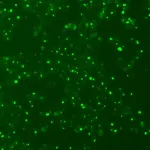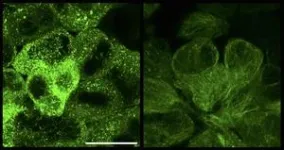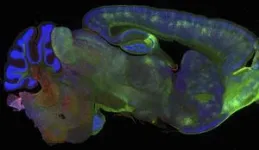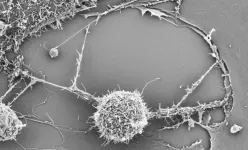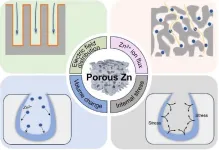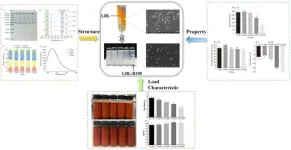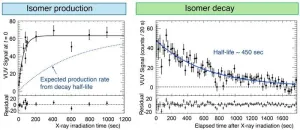(Press-News.org) Scientists have developed new potential therapies that selectively remove aggregated tau proteins, which are associated with Alzheimer’s disease, and improve symptoms of neurodegeneration in mice.
The team of scientists, from the Medical Research Council Laboratory of Molecular Biology (MRC LMB) in Cambridge, UK, and the UK Dementia Research Institute (UK DRI) at the University of Cambridge, say this promising approach could also be applied in future to other brain disorders driven by protein aggregation inside cells, such as motor neuron disease, Huntington’s disease and Parkinson’s disease.
In two papers, published in Cell and Science, they demonstrated how utilising the unique capabilities of a protein called TRIM21 gives the potential therapies two key advantages. Firstly, they only destroyed the disease-linked tau aggregates, leaving healthy tau proteins intact. And secondly, the therapies removed already established tau aggregates in mice, not just preventing the formation of new aggregates.
Tau tangles
There are two main proteins that become misfolded and accumulate into aggregates in the brains of people affected by Alzheimer’s disease: tau and amyloid.
Amyloid aggregates form in the spaces between brain cells, where they are being targeted by new antibody therapies, such as lecanemab.
In contrast, tau ‘tangles’ largely form inside nerve cells, although aggregates can spread from cell to cell, which is strongly associated with cognitive decline as the disease progresses.
It is difficult for antibody therapies to access tau inside cells, therefore they do not remove existing tau aggregates inside cells – at best they prevent aggregates from spreading.
Other techniques for targeting tau inside cells, such as anti-sense oligonucleotides (ASOs), have been shown to reduce tau in promising early-stage clinical trials. However, they act on all tau in the brain and therefore also remove ‘healthy’ tau – the long-term side-effects of this are not yet known.
‘Healthy’ tau protein normally helps to provide structural support inside nerve cells in the brain – acting as a type of scaffolding.
Trimming Alzheimer’s-linked proteins
This new technique for targeting tau tangles utilises a 2010 discovery from Dr Leo James’ lab at the MRC Laboratory of Molecular Biology of the role of a unique protein called TRIM21, which is a key part of the immune response to viruses.
Outside the cell, the body produces antibodies that bind to invading viruses. When the antibody-bound virus enters a cell, TRIM21 detects it and tags the virus as ‘garbage’, handing it over to the cell’s ‘garbage chute’, the proteasome, for destruction.
The same team, working across the UK DRI and MRC LMB, demonstrated in 2023 that TRIM21 could be re-purposed to destroy tau protein aggregates associated with Alzheimer’s disease. By switching out antibodies that bind viruses for antibodies that bind to tau, TRIM21 was re-directed to send tau aggregates to be destroyed by the proteasome.
TRIM21 is particularly suited to this because of a special feature – a part of the protein called ‘RING’ that is activated only when two or more TRIM21 proteins cluster together. This means that it only activates and marks its target for destruction when TRIM21 proteins are bound to adjacent, aggregated tau proteins.
New Trojan horse therapy for tau aggregates
In the new studies, scientists have used TRIM21 to create two new therapies to target tau aggregates.
The first therapy, ‘RING-nanobody’, combines a tau-binding nanobody – a miniature version of an antibody – with the TRIM21 RING.
The second therapeutic, ‘RING-Bait’, has the TRIM21 RING joined to a copy of the tau protein itself. The RING-linked tau protein acts as bait – the aggregates incorporate it and TRIM21 RING gets incorporated as well. Once multiple RING-Baits are added to the aggregate, they become activated and causes the entire aggregate to be destroyed.
The researchers delivered the DNA encoding the TRIM21 therapies into cells containing aggregated tau and found it cleared the tau tangles. As hoped, ‘healthy’ tau was left undamaged.
Dr Will McEwan, co-leader of the studies, from the UK Dementia Research Institute at the University of Cambridge said: “Tau aggregates are tucked away inside brain cells and very difficult to degrade. Critically, these new TRIM21-based therapies can be delivered directly inside cells, where the majority of tau aggregates reside.
“We’ve found a way that not only degrades the tau aggregates, but leaves the healthy tau intact to do its job. The new strategy goes beyond what can be achieved with current ASO therapies that are being trialled, as it could avoid any potential long-term side-effects of eliminating normal tau.”
Since different neurodegenerative diseases can have different types of misfolded tau, they tested the therapies on cells containing aggregated tau proteins from brain tissue donated by people who had Alzheimer’s disease or progressive supranuclear palsy, which have different misfolded tau structures. The RING-Bait therapy was able to prevent tau aggregation induced by proteins from both Alzheimer’s and progressive supranuclear palsy patient brains.
Dr Leo James, co-leader of the studies, from the MRC Laboratory of Molecular Biology in Cambridge, said: “Neurodegenerative diseases can have tau proteins that misfold in many different ways, raising the possibility of needing a different treatment for every disease. A useful aspect of RING-Bait is because it is attached to a tau protein, it’s a universal Trojan horse that should be incorporated into different types of tau aggregates exactly like the cell’s own misfolding tau protein.”
Mice walk better after therapy
For the treatment to work in an animal, it needs to not only get into the brain, but also get inside the cells within the brain. To do this, the researchers used a harmless virus that has previously been developed to deliver therapies like this, called an adeno-associated virus (AAV). It delivers DNA instructions to make the custom proteins inside brain cells.
Elderly mice with tau protein aggregates were injected with a single dose of the gene therapy vector containing either the treatment, or a placebo.
Within a few weeks, there was a significant reduction in the amount of aggregated tau in the brain cells of the treated animals.
Importantly, in the mice given the RING-Bait treatment, the progression of their neurodegeneration symptoms slowed and they showed significantly better motor function, as assessed by an AI programme that scored how well they ran.
Dr Lauren Miller, a study author, who worked across both the UK Dementia Research Institute and MRC Laboratory of Molecular Biology, said: “It was unknown whether specifically removing tau aggregates inside the cell would be enough to halt the progression of disease. It is encouraging that a RING-Bait approach reduces disease severity in our model systems, as this suggests that the selective removal of tau aggregates is a valid therapeutic approach. Further work will be needed to demonstrate this beneficial effect is found across multiple models of human disease.”
Dr Guido Papa, a study author, from MRC Laboratory of Molecular Biology, said: “The beauty of RING-Bait lies in its broad adaptability and the potential to tackle other conditions characterised by the accumulation of pathological protein clusters. Other neurodegenerative diseases are caused by aggregates formed by other proteins, such as TDP43 in motor neuron disease and alpha-synuclein in Parkinson’s disease. It is hoped that RING-Bait will allow the development of future therapies that directly target the aggregation process in these diseases.”
The scientists caution that these therapies still require a lot of development before they can be tested in humans, particularly developing an AAV vector that can safely and effectively deliver RING-nanobody or RING-bait therapies to cells throughout the human brain.
Dr Jonathan Benn, a study author, from the UK Dementia Research Institute at the University of Cambridge, said: “It’s important to stress that although we have shown it works in a mouse model, this is a long way from a therapeutic that could be used in humans. It would need to be determined that it is safe to use TRIM21-based therapies in the human brain and that the treatments are effective in both removing aggregates and improving the course of disease.
“Some AAV vectors are already approved for use in humans – for instance in degenerative eye diseases and genetic diseases like spinal muscular atrophy. However, getting enough AAV into the adult brain remains a significant challenge - the human brain is about 1,000 times bigger than a mouse brain. But this is a rapidly moving field and there are cutting edge gene delivery methods that we hope will allow our therapies to be delivered at scale in the future.”
These studies were primarily funded by Wellcome, MRC, UK DRI, and The Lister Institute of Preventative Medicine.
END
New therapy that targets and destroys tau tangles is a promising future Alzheimer’s disease treatment
2024-09-13
ELSE PRESS RELEASES FROM THIS DATE:
Study finds ‘supercharging’ T cells with mitochondria enhances their antitumor activity
2024-09-13
Fighting cancer is exhausting for T cells. Hostile tumor microenvironments can drain their mitochondrial activity, leading to a condition known as T cell exhaustion. This phenomenon also hinders adoptive cell therapies, in which healthy, tumor-targeting T cells are infused into patients with cancer. A novel method to boost mitochondrial activity and charge up T cells is needed.
Investigators from Brigham and Women’s Hospital, a founding member of the Mass General Brigham healthcare system, in collaboration with colleagues at Leibniz Institute for Immunotherapy in Germany, have developed a way to “supercharge” T cells by supplying them with extra mitochondria ...
Harnessing the power of porosity: A new era for aqueous zinc-ion batteries and large-scale energy storage
2024-09-13
As the global demand for energy storage solutions grows, the limitations of current lithium-ion batteries, such as safety concerns and high costs, have driven the exploration of alternative technologies. Aqueous zinc-ion batteries (AZIBs) have emerged as a promising candidate due to their inherent safety, cost-effectiveness, and environmental sustainability. However, challenges like zinc dendrite growth continue to hinder their widespread adoption. Due to these challenges, there is a pressing need to delve deeper ...
Antibody-drug conjugate found effective against brain metastases in patients with HER2-positive breast cancer
2024-09-13
Trastuzumab deruxtecan shows substantial anti-cancer activity in brain metastases in patients with HER2-positive breast cancer in major international clinical trial
Results confirm findings of previous, smaller studies
BARCELONA, Spain - A drug that delivers chemotherapy directly to tumors has shown impressive activity against some of the hardest-to-reach cancer cells: those that have spread to the brain in patients with advanced HER2-positive breast cancer. The findings, from an international clinical trial led by Dana-Farber Cancer Institute researchers, reinforce earlier findings of the benefits ...
Bacteria work together to thrive in difficult conditions
2024-09-13
COLUMBUS, Ohio – Though a founding concept of ecology suggests that the physical environment determines where organisms can survive, modern scientists have suspected there is more to the story of how microbial communities form in the soil.
In a new study, researchers have determined through both statistical analysis and in experiments that soil pH is a driver of microbial community composition – but that the need to address toxicity released during nitrogen cycling ultimately shapes the final microbial community.
“The physical environment is affecting the nature of microbial interactions, and that affects the assembly of the community,” ...
An ‘invasive’ marine organism has become an economic resource in the eastern Mediterranean
2024-09-13
Media Contact:
John Dudley
(814) 490-3290 (cell)
jjdudley@usf.edu
KEY TAKEAWAYS:
A species of single-celled organisms called foraminifera (forams) is increasing in warm, alkaline waters of the eastern Mediterranean, building beaches with their calcium carbonate skeletons.
In regions like Turke, forams are creating sandy shorelines where there used to be rocky terrain, benefiting tourism.
Forams thrive in warm waters with high CO2, suggesting they might continue growing as climate change accelerates.
This species of foram, once native to the Mediterranean, is returning as human activities make ...
Unveiling the math behind your calendar
2024-09-13
In a world where organizing a simple meeting can feel like herding cats, new research from Case Western Reserve University reveals just how challenging finding a suitable meeting time becomes as the number of participants grows.
The study, published in the European Physical Journal B, dives into the mathematical complexities of this common task, offering new insights into why scheduling often feels so impossible.
“If you like to think the worst about people, then this study might be for you,” quipped researcher Harsh Mathur, ...
New research finds employees feel pressure to work while sick, which has been shown to cost companies billions
2024-09-13
EMBARGOED FOR RELEASE UNTIL 9 A.M. ET ON SEPT. 13, 2024
TAMPA, Fla. (Sept. 10, 2024) – Employees often feel pressure to work while sick, leading to lost productivity, deviant behaviors such as theft and mistreatment of coworkers and intent to leave the organization, according to new research led by University of South Florida Assistant Professor of Psychology Claire Smith. The cost of such behavior, known as “presenteeism,” can be staggering – as much as $150 billion annually, according to Harvard Business Review.
The findings will be ...
Harnessing egg yolk power: A new approach to paprika oleoresin stability
2024-09-13
Paprika oleoresin (PO), extracted from chili peppers, is renowned for its vibrant color and beneficial health properties, such as antioxidant and anti-inflammatory effects. However, its lipophilic nature and sensitivity to factors like oxygen, heat, and light restrict its use in water-based foods. While previous approaches, including emulsions and liposomes, have aimed to improve PO’s stability, the results have been limited. These persistent challenges underscore the need for new stabilization methods for PO.
The study (DOI: 10.26599/FSAP.2024.9240064), led by scientists from Chengdu University and Huazhong Agricultural ...
Millions of depressed Americans could benefit from psychedelic therapy, study finds
2024-09-13
Atlanta, Georgia - In the wake of mounting evidence for the efficacy of psychedelic-assisted therapies, the U.S. Food and Drug Administration (FDA) is considering approving psilocybin, the active ingredient in “magic mushrooms,” for treating depression in the near future. As this watershed moment approaches, a critical question arises: Just how many people might stand to benefit from this promising but still unproven therapy?
Shedding light on this high-stakes inquiry, a first-of-its-kind peer-reviewed study led by researchers at Emory University, the University of Wisconsin-Madison and ...
Towards the realization of compact and portable nuclear clocks
2024-09-13
Scientists use atomic clocks to measure ‘second,’ the smallest standard unit of time, with great precision. These clocks use natural oscillations of electrons in atoms, similar to how pendulums work in old grandfather clocks. The quest for an even more precise timekeeper led to the discovery of nuclear clocks, which use the transitions of atomic nuclei instead of electrons to keep time.
A rising contender for the development of ultra-precise nuclear optical clocks is the nuclear first-excited state of 229Th isotope. Its long half-life of 103 seconds and low excitation energy of a few electron ...
